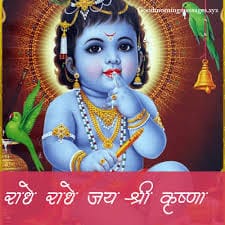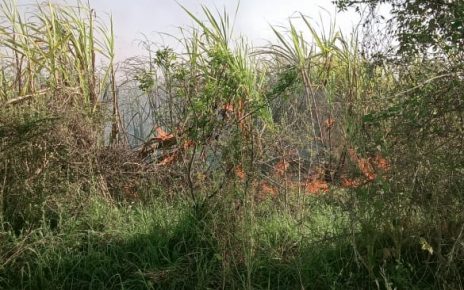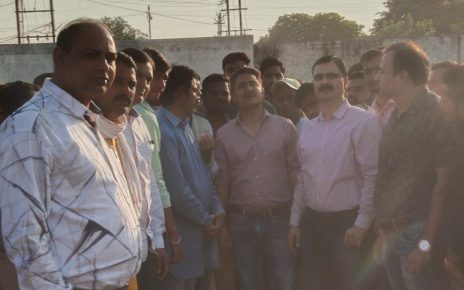 The Heliodorus Pillar, a stone pillar with a Brahmi script inscription was discovered by colonial era archaeologists in Besnagar (Vidisha, central Indian state of Madhya Pradesh). Based on the internal evidence of the inscription, it has been dated to between 125 and 100 BCE, and now known after Heliodorus – an Indo-Greek who served as an ambassador of the Greek king Antialcidas to a regional Indian king Kasiputra Bhagabhadra.[43][46] The Heliodorus pillar inscription is a private religious dedication of Heliodorus to “Vāsudeva”, an early deity and another name for Krishna in the Indian tradition. It states that the column was constructed by “the Bhagavata Heliodorus” and that it is a “Garuda pillar” (both are Vishnu-Krishna-related terms). Additionally, the inscription includes a Krishna-related verse from chapter 11.7 of the Mahabharata stating that the path to immortality and heaven is to correctly live a life of three virtues: self-temperance (damah), generosity (cagah or tyaga), and vigilance (apramadah).[46][48][49] The Heliodorus pillar site was fully excavated by archaeologists in the 1960s. The effort revealed the brick foundations of a much larger ancient elliptical temple complex with a sanctum, mandapas, and seven additional pillars.[50][51] The Heliodorus pillar inscriptions and the temple are among the earliest known evidence of Krishna-Vasudeva devotion and Vaishnavism in ancient India.[52][43][53]
The Heliodorus Pillar, a stone pillar with a Brahmi script inscription was discovered by colonial era archaeologists in Besnagar (Vidisha, central Indian state of Madhya Pradesh). Based on the internal evidence of the inscription, it has been dated to between 125 and 100 BCE, and now known after Heliodorus – an Indo-Greek who served as an ambassador of the Greek king Antialcidas to a regional Indian king Kasiputra Bhagabhadra.[43][46] The Heliodorus pillar inscription is a private religious dedication of Heliodorus to “Vāsudeva”, an early deity and another name for Krishna in the Indian tradition. It states that the column was constructed by “the Bhagavata Heliodorus” and that it is a “Garuda pillar” (both are Vishnu-Krishna-related terms). Additionally, the inscription includes a Krishna-related verse from chapter 11.7 of the Mahabharata stating that the path to immortality and heaven is to correctly live a life of three virtues: self-temperance (damah), generosity (cagah or tyaga), and vigilance (apramadah).[46][48][49] The Heliodorus pillar site was fully excavated by archaeologists in the 1960s. The effort revealed the brick foundations of a much larger ancient elliptical temple complex with a sanctum, mandapas, and seven additional pillars.[50][51] The Heliodorus pillar inscriptions and the temple are among the earliest known evidence of Krishna-Vasudeva devotion and Vaishnavism in ancient India.[52][43][53]
Balarama and Krishna with their attributes at Chilas. The Kharoshthi inscription nearby reads Rama [kri]ṣa. 1st century CE.[42]
The Heliodorus inscription is not isolated evidence. The Hathibada Ghosundi Inscriptions, all located in the state of Rajasthan and dated by the modern methodology to the 1st century BCE, mention Saṃkarṣaṇa and Vāsudeva, also mention that the structure was built for their worship in association with the supreme deity Narayana. These four inscriptions are notable for being some of the oldest-known Sanskrit inscriptions.[54]
A Mora stone slab found at the Mathura-Vrindavan archaeological site in Uttar Pradesh, held now in the Mathura Museum, has a Brahmi inscription. It is dated to the 1st century CE and mentions the five Vrishni heroes, otherwise known as Saṃkarṣaṇa, Vāsudeva, Pradyumna, Aniruddha, and Samba.[55][56][57]
The inscriptional record for Vāsudeva starts in the 2nd century BCE with the coinage of Agathocles and the Heliodorus pillar, but the name of Krishna appears rather later in epigraphy. At Chilas II archeological site dated to the first half of 1st-century CE in northwest Pakistan, near the Afghanistan border, are engraved two males along with many Buddhist images nearby. The larger of the two males hold a plough and club in his two hands. The artwork also has an inscription with it in Kharosthi script, which has been deciphered by scholars as Rama-Krsna, and interpreted as an ancient depiction of the two brothers Balarama and Krishna.[58][59]
The first known depiction of the life of Krishna himself comes relatively late with a relief found in Mathura, and dated to the 1st-2nd century CE.[60] This fragment seems to be showing Vasudeva, Krishna’ father, carrying baby Krishna in a basket across the Yamuna.[60] The relief shows at one end a seven-hooded Naga crossing a river, where a makara crocodile is thrashing around, and at the other end a person seemingly holding a basket over his head.[60]
Literary sources



